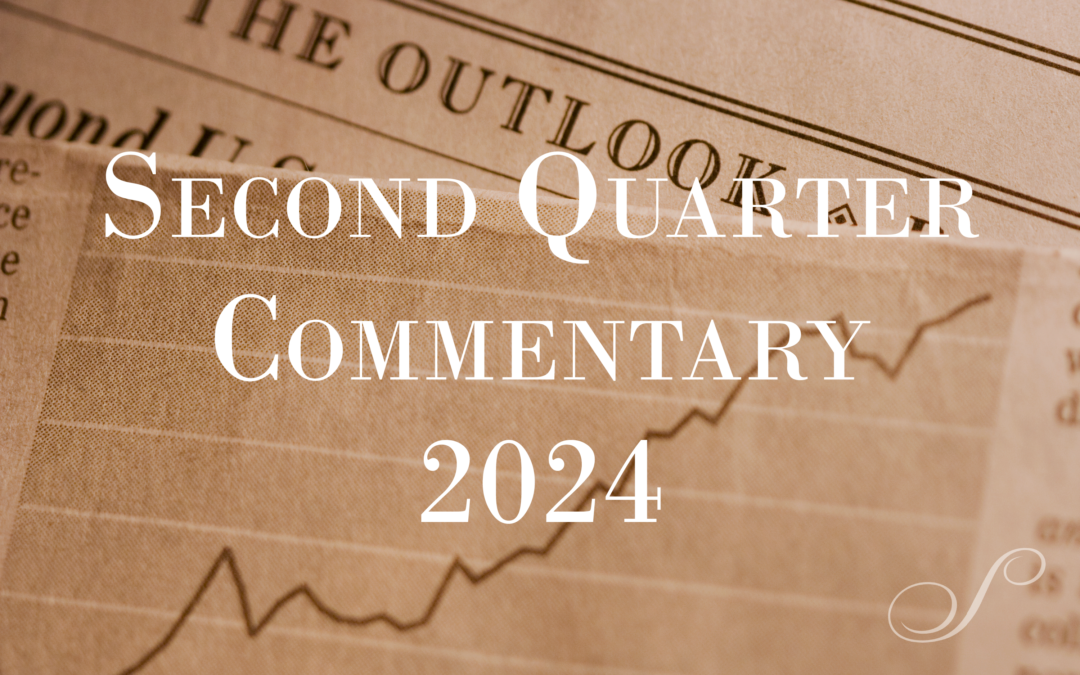The US economy slowed in the first half of the year with GDP growing at about 1.4%, while the S&P 500 gained 15.29% and the US Aggregate Bond index was down .71%. Approximately 34% of the gains in the S&P 500 YTD came from NVIDIA stock alone. Inflation increased in the first quarter but subsided in the second quarter and continues to be driven by the Shelter and Auto Insurance components. The net worth of all households has increased 14% over the last 18 months, which should be supportive of consumer spending and the economy. The labor market is normalizing with nonfarm payrolls trending lower, job openings declining, and the jobs quits rate stabilizing which should hold down wage growth. There is concentration risk growing in the top 10 US stocks as a percentage of the total market, federal debt as a percentage of GDP, and income inequality. These on their own are not particularly worrisome but should there be an unforeseen shock to the economy they could exacerbate it, which is why we focus on diversification in the portfolio.
Inflation peaked at 9.1% in June 2022 and fell to 3% in June this year which was below estimates and the slowest pace since January’s 2021’s COVID spike. Inflation continues to fall but at a slower rate driven by the stickier shelter and auto insurance components which should dissipate over the coming year or two. The headline Consumption Deflator, which the FED focuses on, went from 2.8% in April to 2.6% in May approaching the FED’s 2% target. This inflationary period affected most developed countries as governments replaced citizens incomes while they had nothing to spend it on during the pandemic. This increased savings led to higher spending once the economy opened again, which drove up prices but also prevented the economic slowdown that many people expected.
The labor market remains strong but has cooled significantly and is coming back into balance. June Nonfarm payrolls rose 206,000, however, the report overall was softer than expected. Downward revisions from earlier reports lowered the three-month average pace to 177,000 from 249,000 as previously expected. The unemployment rate increased to 4.1% as a 277,000 increase in the size of the labor force offset a 166,000 increase in household employment. The industry composition of the Jobs report was also because the government and health care sectors accounted for three quarters of the June job gains while the cyclical sectors shed jobs. Job openings have come down significantly from the peak and while job openings are still higher than they were before the pandemic the quits rate is lower. This is important because workers quit when they think they can get better wages elsewhere, so this is a sign that wage inflation has cooled, and the labor market is becoming more in balance.
The US economy has performed better than expected since the FED started aggressively tightening monetary policy, however, it has begun to slow. The slowing of the economy is not necessarily a bad thing. That along with a considerable cooling of the labor market and a decrease in inflation is starting to give the FED what it needs to begin cutting interest rates. FED chair Jerome Powel said that “more good data would strengthen our confidence that inflation is moving sustainably toward 2%”. So far, as indicated in the last CPI and Jobs report, we are seeing more good data. This has led the market to begin pricing in the first interest rate cut at the September meeting. As of now the outlook is for two interest rate cuts this year and four next year. Although the economy is slowing most signs point to a greater probability of a soft landing than a recession.
Equity markets globally have done well this year although the US has significantly outperformed. The US stock market now accounts for 64% of the market cap of global equities. This outperformance can be primarily attributed to large cap technology companies. The top ten companies in the S&P 500 now make up 37% of the index. NVIDIA alone accounted for 34% of the gains in the S&P 500 while the Magnificent 7 (Apple, Amazon, Alphabet, Meta, Microsoft, NVIDIA, and Tesla) accounted for 64% of the gains. The Magnificent 7 were up 43% in the first half of the year while the S&P 500 ex-Mag 7 was only up 6%. Microsoft, Apple, and NVIDIA each on their own are larger than the market cap of every country’s stock market except for the US and Japan. This illustrates the concentration risk in the stock market and while we have maintained a healthy exposure to these names, we have also focused on diversification in the event there is a rotation or broadening of the market.
The increase in technology stocks was partially due to the investment in Artificial Intelligence. Capital spending on data centers by AI hyperscalers increased from $126 Billion in 2023 to $183 Billion in 2024. This is about a quarter of the investment that will be spent on non-residential structures this year. It is estimated that the electricity used to power these data centers for AI and Crypto currency will increase 1.8 times by the end of 2026 from their 2022 levels and use about 6% of US electricity production.
In conclusion, we continue to see solid but slower economic growth and the risk factors for a recession remain lower than many previously thought. The labor market is coming back into equilibrium and the risk of wage inflation has diminished. If the data continues to support slower economic growth, a weaker labor market, and slowing inflation we would expect the FED to begin its rate cutting cycle in September. Stocks did well in the first half of the year; however, much of the performance was attributed to a small number of companies. A pullback in the market would not be uncommon after the gains we have had; however, we continue to have a positive long-term outlook.
Certainly, reach out to me (Michael) or your advisor with any specific questions you may have.
All our best,
The Management Team
Michael, Michelle, and Jolie
Important Disclosure Information
Please remember that past performance may not be indicative of future results. Different types of investments involve varying degrees of risk, and there can be no assurance that the future performance of any specific investment, investment strategy, or product (including the investments and/or investment strategies recommended or undertaken by Socha Financial Group, LLC (“SFG”), or any non-investment related content, made reference to directly or indirectly in this commentary will be profitable, equal any corresponding indicated historical performance level(s), be suitable for your portfolio or individual situation, or prove successful. Due to various factors, including changing market conditions and/or applicable laws, the content may no longer be reflective of current opinions or positions. Moreover, you should not assume that any discussion or information contained in this commentary serves as the receipt of, or as a substitute for, personalized investment advice from Socha. Please remember to contact Socha, in writing, if there are any changes in your personal/financial situation or investment objectives for the purpose of reviewing/evaluating/revising our previous recommendations and/or services, or if you would like to impose, add, or to modify any reasonable restrictions to our investment advisory services. Socha is neither a law firm, nor a certified public accounting firm, and no portion of the commentary content should be construed as legal or accounting advice. A copy of the SFG’s current written disclosure Brochure discussing our advisory services and fees continues to remain available upon request.
Historical performance results for investment indices, benchmarks, and/or categories have been provided for general informational/comparison purposes only, and generally do not reflect the deduction of transaction and/or custodial charges, the deduction of an investment management fee, nor the impact of taxes, the incurrence of which would have the effect of decreasing historical performance results. It should not be assumed that your Socha account holdings correspond directly to any comparative indices or categories. Please Also Note: (1) performance results do not reflect the impact of taxes; (2) comparative benchmarks/indices may be more or less volatile than your Socha accounts; and (3) a description of each comparative benchmark/index is available upon request.
Please Note: Limitations: Neither rankings and/or recognition by unaffiliated rating services, publications, media, or other organizations, nor the achievement of any designation or certification, should be construed by a client or prospective client as a guarantee that he/she will experience a certain level of results if Socha is engaged, or continues to be engaged, to provide investment advisory services. Rankings published by magazines, and others, generally base their selections exclusively on information prepared and/or submitted by the recognized adviser. Rankings are generally limited to participating advisers (see link as to participation data/criteria, to the extent applicable). Unless expressly indicated to the contrary, Socha did not pay a fee to be included on any such ranking. No ranking or recognition should be construed as a current or past endorsement of Socha by any of its clients. ANY QUESTIONS: SFG’s Chief Compliance Officer remains available to address any questions regarding rankings and/or recognitions, including the criteria used for any reflected ranking.
Print Second Quarter Commentary – 2024

